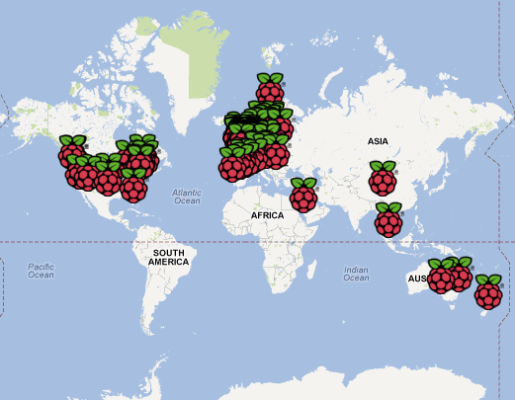One to 1.2 million Raspberry Pi microcomputers have shipped since the device’s launch just over a year ago but where in the world are they located? While it’s impossible to say exactly where* each Pi has ended up, the vast majority of the devices sold to-date have shipped to developed nations — including the U.S. and the U.K. But the potential of the Pi as a low cost learning-focused computing platform for developing countries remains very exciting.
Last week the U.K.-based Pi Foundation blogged about a volunteer group that had taken a suitcase-worth of Pis to a school in rural Cameroon where they are being used to power a computer class. At $35 apiece, and even $25 for the Model A Pi, the Pi does a lot to break down the affordability barrier to computing — although it still requires additional peripherals (screen, keyboard, mouse) to turn it into a fully fledged computer terminal.
Asked about the global sales distribution of the Pi, the Foundation provided TechCrunch with some “very rough”, internal estimates of Pi sales to developing/emerging nations — and the figures (listed below) suggest that the first million+ Pi sales have overwhelmingly been powered by wealthier nations.
The most Pi-populous country on the developing/emerging nations list (India) can lay claim to roughly 0.5%-0.6% of total global Pi sales to-date, according to this data. While, collectively, these listed nations make up between only 1.4% and 1.7% of total global Pi shipments. So more than 98% of the Pi pie has been sold to the world’s wealthiest countries thus far.
| India | 6000 |
| Indonesia | 1200 |
| Lao P.Dem.R. | 600 |
| Malaysia | 3400 |
| Philippines | 500 |
| Pakistan | 100 |
| Sri Lanka | 50 |
| Thailand | 2000 |
| Vietnam | 500 |
| Egypt | 150 |
| South Africa | 2000 |
| Tunisia | 200 |
| Zimbabwe | 50 |
| Bolivia | 100 |
| Chile | 400 |
| Colombia | 20 |
| Peru | 50 |
There are also, of course, scores of (apparently) Pi-less developing nations that do not make this list at all. One of which — the Kingdom of Bhutan — does actually have a princely one Pi sale to its name at present, according to the Foundation. “It’s a server for Khan Academy Lite in a school, whose 64GB SD card costs more than twice what the Pi cost,” the Foundation’s Liz Upton tells TechCrunch. “We’re working on getting more out there!”
It’s likely that some of the Pis shipped to developed countries have found their way to less wealthy nations — via charities and other ‘suitcase schemes’ such as the Cameroon school project mentioned above which took out 30 Pis. Or via individual buyers seeking to avoid high import tariffs that can push up the price of bulk commercial imports (such as in Brazil).
But even factoring in some extra spread, there’s no doubt the Pi is predominantly disrupting the living rooms and schools of the developed world. Which, it should be noted, was the original ambition of the Pi founders — specifically they wanted to get more U.K. kids coding, following a national slump in interest in computer science education.
But the Pi’s unexpected popularity has generated additional momentum for the project — and even grander geographical ambitions.
“We’re weighted very strongly towards the developed world,” admits Pi founder Eben Upton, when he sends the data, but he says that this spread — or rather concentration — is something the Foundation is keen to work on. “A major challenge for us this year is to find ways of making Pi more available, and more appealing, in these [developing/emerging] markets,” he says.
The Pi hardware seems to offer huge potential to the developing world — being cheaper than most mobile phones, let alone most smartphones — the other device touted as the likely first computing experience for connecting the “next billions” to the Internet. The Pi is also cheaper than another Linux-based low cost learning-focused computing project: the one laptop per child’s XO laptop. And it has an advantage over general Linux PCs or Android tablets in being conceived and supported as first and foremost a learning environment, making it well-suited to push into schools.
As for low cost PCs in general, the netbook category — still more expensive than Pi — is facing extinction by 2015, according to analyst IHS iSuppli, which has put out a forecast today predicting zero netbook shipments within two years, and just 3.97 million units globally this year.
As the traditional desktop PC declines, it’s great to see the rise of a new computing device that, unlike the slick consumer tablets du jour, is intended to encourage hacking, tinkering and learning about hardware and software, rather than passive consumption of prepackaged apps — in the best tradition of the home computer. And a device which also, thanks to its tiny price-tag, has such huge disruptive potential.
So here’s hoping a lot more of the next million+ Pis end up very far from home indeed.
*At the time of writing, the Rastrack map, a project to get Pi-owners to report the location of their Pi and plot the owner locations on a map, was not accessible. The map is used in the feature image at the top of this post, showing a snapshot of self-reported Pi distribution in May last year
